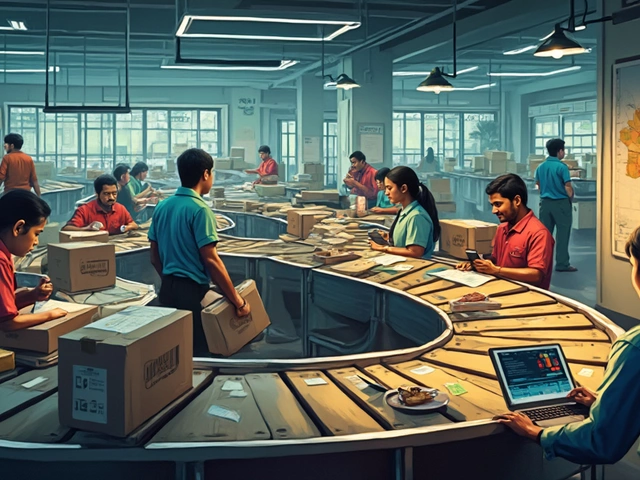The logistics world doesn’t slow down for anyone. Shipments run late, customers get impatient, and a single accident can throw a whole schedule into chaos. You might think it’s all about moving boxes from A to B, but there’s way more behind the scenes—tight timelines, less-than-perfect traffic, and endless pressure to deliver on promises.
Truck drivers juggle weird hours, dispatchers field endless calls, and warehouse teams hustle to meet daily targets. It’s no wonder burnout creeps in—one recent survey found that around 60% of logistics staff reported feeling stressed at least once a week. The kicker? A lot of this stress comes from things nobody can control, like weather turning ugly or tech systems going down at the worst moment.
But here’s the good news. Some companies are starting to tackle these stress triggers head-on. Automation is streamlining repetitive tasks, and better planning tools help teams stay one step ahead of the chaos. Small everyday changes—like better break policies or open communication channels—are also making a dent in daily pressure. If you’re thinking about working in logistics or just want to understand what people deal with, you’ll want to dig deeper into what really causes the stress and what actually helps.
- What Makes Logistics So Demanding?
- Biggest Stress Triggers in Day-to-Day Operations
- Impact on Workers: What It Feels Like
- Smart Ways to Manage Stress in Logistics
- How Top Companies Are Changing the Game
What Makes Logistics So Demanding?
If you ask anyone in logistics, they’ll say the biggest squeeze comes from juggling crazy schedules and razor-thin delivery windows. Customers expect next-day shipping or faster, so there’s zero wiggle room for mistakes. One small delay snowballs into a heap of angry calls and last-minute firefighting.
The industry runs 24/7. Warehouses don’t sleep, and drivers are out in all sorts of weather, day and night. Since logistics companies are part of global supply chains, problems halfway around the world—like a ship stuck in the Suez Canal—can mess up everyone’s plans for days or weeks.
Keeping things on track requires nonstop coordination between drivers, dispatchers, warehouse workers, and even IT staff. It doesn’t help that everything is measured and tracked—speed, accuracy, cost, and customer satisfaction. Miss a target, and someone’s asking why.
| Common Pressure Points in Logistics | Why They Matter |
|---|---|
| Unpredictable traffic and weather | Delays mean late deliveries and unhappy customers |
| Tight labor market | Too few workers leads to burnout and longer shifts |
| Rising costs (fuel, maintenance) | Companies have to do more with less |
| Customer expectations | Fast, error-free shipments are now the norm |
Add to all that the physical side of things. Warehouse staff lift heavy boxes all day. Truck drivers sit for hours and handle the stress of city traffic and deadlines. Tech glitches can bring everything to a halt, so there’s always a backup plan on standby—but those don’t always work smoothly, either.
In short, logistics companies deal with constant pressure from all sides—customers, bosses, even unpredictable forces like weather and markets. No surprise it’s a high-stress game, demanding quick thinking, teamwork, and endless patience just to keep cargo moving where it needs to go.
Biggest Stress Triggers in Day-to-Day Operations
When people talk about stress in logistics, they usually mean the stuff that hits them every single day. It’s not always the big disasters—most of the headaches come from the small but constant fires that never seem to stop. Let’s get super clear on what really pushes people over the edge in this industry.
First up, tight deadlines top the list. Everything in the supply chain is built on timing. Miss one cutoff, and you can end up delaying dozens of shipments. Truck drivers deal with changing traffic, while warehouse teams scramble to load and unload without making mistakes. If you’ve ever felt rushed by the clock, multiply that by ten in a busy logistics center.
Communication hiccups are another daily pain. It’s not just about answering phone calls or emails—when messages go missing or get mixed up, entire orders can get lost or sent to the wrong place. A study by Logistics Management in 2024 found that 49% of distribution managers blamed unclear instructions for unnecessary mishaps. Here’s how that stacks up:
| Top Stress Trigger | % of Respondents Impacted |
|---|---|
| Missed Deadlines | 62% |
| Messed-Up Communications | 49% |
| Technology Failures | 34% |
System or tech problems hit hard too. When tracking software goes offline or a scanner dies mid-shift, teams have to scramble, sometimes resorting to manual tracking—way less efficient and super stressful.
Let’s not forget external factors. Bad weather, accidents, or sudden spikes in orders (think Black Friday) all throw a wrench in even the best-laid plans. As Michael Jones from the Council of Supply Chain Management said,
"The biggest surprises in logistics usually aren’t the ones you can plan for—it's the stuff that happens out of nowhere, and that’s what really wears people down over time."
Daily stressors boil down to:
- Unrealistic delivery windows
- Poor or broken communication
- Technical glitches and outages
- Sudden changes in demand or huge order volumes
- Traffic jams, weather, and accidents
Handling these triggers isn’t easy. The good news? Knowing what causes the pressure is a solid first step to actually doing something about it. That’s where better tools, smart policies, and more support can make a difference.

Impact on Workers: What It Feels Like
Working in logistics is a little like running on a treadmill that keeps speeding up. Most jobs in this industry, whether you’re a truck driver, dispatcher, or working in a warehouse, are fast-paced and come with a sense that any mistake could snowball into a huge problem for the rest of the team. This pressure turns up the dial on stress pretty fast.
Let’s get real—shippers and drivers are expected to work weekends, late nights, and even holidays. That’s tough on anyone’s social life. The job rarely sticks to a nine-to-five. One study by the UK’s Health and Safety Executive showed that people in supply chain roles report higher-than-average stress and anxiety compared with other careers. There’s a reason for that: they’re often judged on delivery times, accuracy, and safety, all at once.
The feeling of always being “on call” makes it hard to relax. Even on days off, lots of workers check their phones just in case something comes up. Warehouse staff might deal with early mornings and repetitive lifting, which can hit both the body and the mind over time. Truckers face fatigue from long hours and little sleep—around 13% of US drivers say they struggle with chronic tiredness. On top of that, mistakes cost money fast, so people get nervous about slipping up.
And it’s not just physical. The mental load is heavy. If a shipment runs late, it’s common to get chewed out by a frustrated client or a stressed-out boss. Sometimes, co-workers take out their pressure on each other, which only stirs the pot more. Here’s a quick look at some numbers that tell the story:
| Issue | % Workers Reporting |
|---|---|
| Feeling stressed weekly | 60% |
| Struggling with work-life balance | 55% |
| Worrying about mistakes | 48% |
But here’s a tip—teams with strong communication tend to manage the stress a bit better. Shout-outs or quick check-ins during shifts make a dent. Some companies are bringing in wellness programs, team lunches, or flexibility in shifts that actually help workers catch their breath. If you land in a place that cares, the atmosphere feels different. People stick around longer, and burnouts don’t happen as much.
Smart Ways to Manage Stress in Logistics
If you’re working in logistics and the stress is getting real, you’re not alone. The good news: there are tried-and-true ways to make each day run smoother and keep you from burning out.
Start with better communication. Teams that meet daily—either face-to-face or online—catch problems early. When everyone’s in the loop, you spend less time putting out fires. One study from the International Journal of Logistics Management found that companies with clear daily check-ins lowered their error rates and slashed overtime by up to 25%.
Tech can be your best friend. Warehouse management systems (WMS) and real-time GPS tracking keep everybody updated and cut down last-minute scrambles. If you’re not using workflow software, you’re basically adding work for yourself. Many logistics companies that switched to digital checklists or automated notifications saw “lost shipment” complaints drop sharply.
Taking decent breaks is huge. It sounds basic, but research shows that truck drivers and warehouse operators who actually use their breaks (and steer clear of screens for a while) handle stress better, sleep better, and make fewer mistakes.
- Break up long shifts: Rotate tasks or create short walk-and-stretch moments every couple hours.
- Use tech for the boring stuff: Automate inventory updates, routine emails, or shipment scheduling.
- Share wins and fixes: Weekly “what went right” sessions boost morale and make teams tighter.
- Encourage buddy systems: Pairing up—as simple as checking in on each other by phone—keeps people from feeling overloaded.
- Ask for feedback: Quick anonymous polls show you where things are bogging down—and managers can actually fix it.
Check out how a company tackled stress by comparing results before and after tech upgrades:
| Before Automation | After Automation |
|---|---|
| Average 3 missed shipments/week | Less than 1 missed shipment/week |
| Frequent overtime requests | 20% drop in overtime |
| High team turnover | Employees sticking around longer |
Bottom line? You can’t totally erase stress in logistics, but with the right tools and a supportive team, you can keep it from running your life.

How Top Companies Are Changing the Game
The smartest logistics companies are ditching old habits and looking for real ways to handle stress. Amazon, for example, has rolled out robots to handle the heavy lifting in many warehouses. This cuts down physical exhaustion for staff and helps orders get out the door faster. UPS invested millions into hand-held tech that gives delivery drivers real-time updates, so they’re not stuck guessing the best routes or schedules.
More companies are now using advanced route-planning software that stats show cuts delivery delays by up to 20%. That means fewer headaches for everyone, from drivers to managers. DHL even has a digital twin of some hubs—a 3D virtual copy to simulate situations and fix problems before they happen in real life.
Here are a few practical steps top dogs are taking:
- Investing in automation: Warehouses with automated picking and packing see fewer errors and less stress for workers.
- Flexible scheduling: Allowing operators to swap shifts or pick up extra hours when it suits them.
- Mental health programs: FedEx offers counseling and support lines for staff who need to talk things out before stress spirals.
- Better communication tools: Real-time chat apps connect dispatch and drivers instantly, so small issues don’t become big crises.
And it’s not just tech—they’re making culture changes too. Maersk, the global shipping giant, holds regular townhalls so workers have a say in how things operate. This kind of open environment makes a big difference, especially when rapid changes hit the supply chain.
Check out this comparison of stress reduction strategies at leading firms:
| Company | Initiative | Reported Stress Drop |
|---|---|---|
| Amazon | Robotic automation in warehouses | Up to 15% |
| FedEx | Mental health support line | 12% |
| UPS | Smart handheld tech for drivers | 10% |
| DHL | Digital twin simulation | 18% |
These steps aren’t about small tweaks—they’re real changes that help people in the thick of logistics work breathe a little easier day to day. There’s still a long road ahead, but it’s clear the industry is waking up to the stress problem and finally doing something about it.





